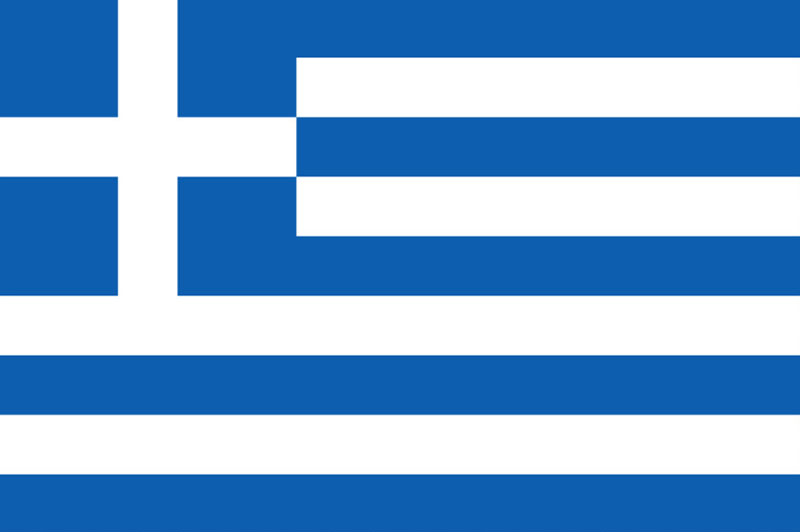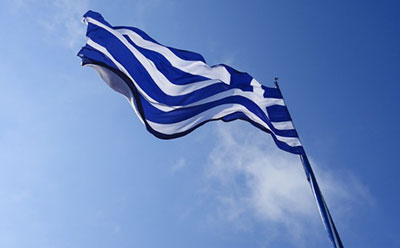When you see or hear about the Greek flag, the first thing that strikes you are those beautiful white and blue colours. Did you ever wonder what those colours stand for or what they symbolize on the national flag of Greece? In this article we will be helping you understand a little bit more about the flag and what it represents for Greek people.

Flag of Greece – Name and colours
Starting with the name of the Greece flag, it’s not just called a “flag”. Greeks call the flag of Greece (Galanolefki) – (ΓΑΛΑΝΟΛΕΥΚΗ) which translates into English as “the white and blue”. Greek people sometimes also call the Greek flag (kyanolefki) – (ΚΥΑΝΟΛΕΥΚΗ) and in English it’s “the azure blue and white”.
There are several versions of the meaning of the colours that the flag of Greece has and why those colours were chosen. One reference says the white and blue colours were chosen because they are the same colours which were used by the army of Alexander the Great when he was ruling the world and creating one of the biggest empires in the world.
Another possible reason why the Greece flag proudly flies the white and blue colours is from Greek mythology. These were the 2 colours of the cloak of Athena – goddess of wisdom and war. Also known as (Athene), she is also the goddess of civilization, courage, law and justice, mathematics, inspiration, strategic warfare, strategy, strength, skill, the arts and crafts.
The national flag of Greece may also have gotten its colours for a more logical reason. The blue on the flag may also represent the sky. Greece gets around 300 days of sunshine and blue skies each year. According to this theory, the white on the Greece flag would symbolize the sea waves. Just think how many Greek islands there are and how many towns and cities in Greece are on the coast. Similarly, the Greek seas and the common white colour of the houses may have given the flag its colour scheme.
One of the other beliefs why the Greek flag gets its white and blue is that the colours represent the birth of the Goddess of beauty Aphrodite. Greek mythology has it that Aphrodite was born from a sea of foam.
The design of the flag of Greece also bares more important symbolism. The white cross in the top left corner of the flag represents the Greek Orthodox religion. For Greeks, religion plays a very important part of life. The church had a very important role during the Greek revolution for independence which started in 1821 against the Ottomans.
Flag of Greece – The design and symbolism
 In the national flag of Greece there are 9 blue and white stripes. This number of stripes on the flag wasn’t just a randomly selected number. Some people believe that the number of stripes is because of the nine Muses (inspirational goddesses of literature, science, and the arts in Greek mythology). The number of stripes on the “Blue and White” may also be for the most known belief which is that there are 9 syllabuses in the phrase “ΕΛΕΥΘΕΡΙΑ Ή ΘΑΝΑΤΟΣ” which translated to English means “Freedom or Death”. This phrase was adopted during the revolution against the Ottoman empire and was symbolising and is still inspiring the determination against the tyranny defying the fear of death like the Greeks did in 1821.
In the national flag of Greece there are 9 blue and white stripes. This number of stripes on the flag wasn’t just a randomly selected number. Some people believe that the number of stripes is because of the nine Muses (inspirational goddesses of literature, science, and the arts in Greek mythology). The number of stripes on the “Blue and White” may also be for the most known belief which is that there are 9 syllabuses in the phrase “ΕΛΕΥΘΕΡΙΑ Ή ΘΑΝΑΤΟΣ” which translated to English means “Freedom or Death”. This phrase was adopted during the revolution against the Ottoman empire and was symbolising and is still inspiring the determination against the tyranny defying the fear of death like the Greeks did in 1821.
Another important fact about the flag of Greece is that it took its final design and colours on 22nd December, 1978. Since then, the Greek flag proudly flies over the sacred rock of the Acropolis in Athens. The flag is of course also found and saluted in every Greek person’s home – no matter whether this is in Greece or in any other country the person lives in.


